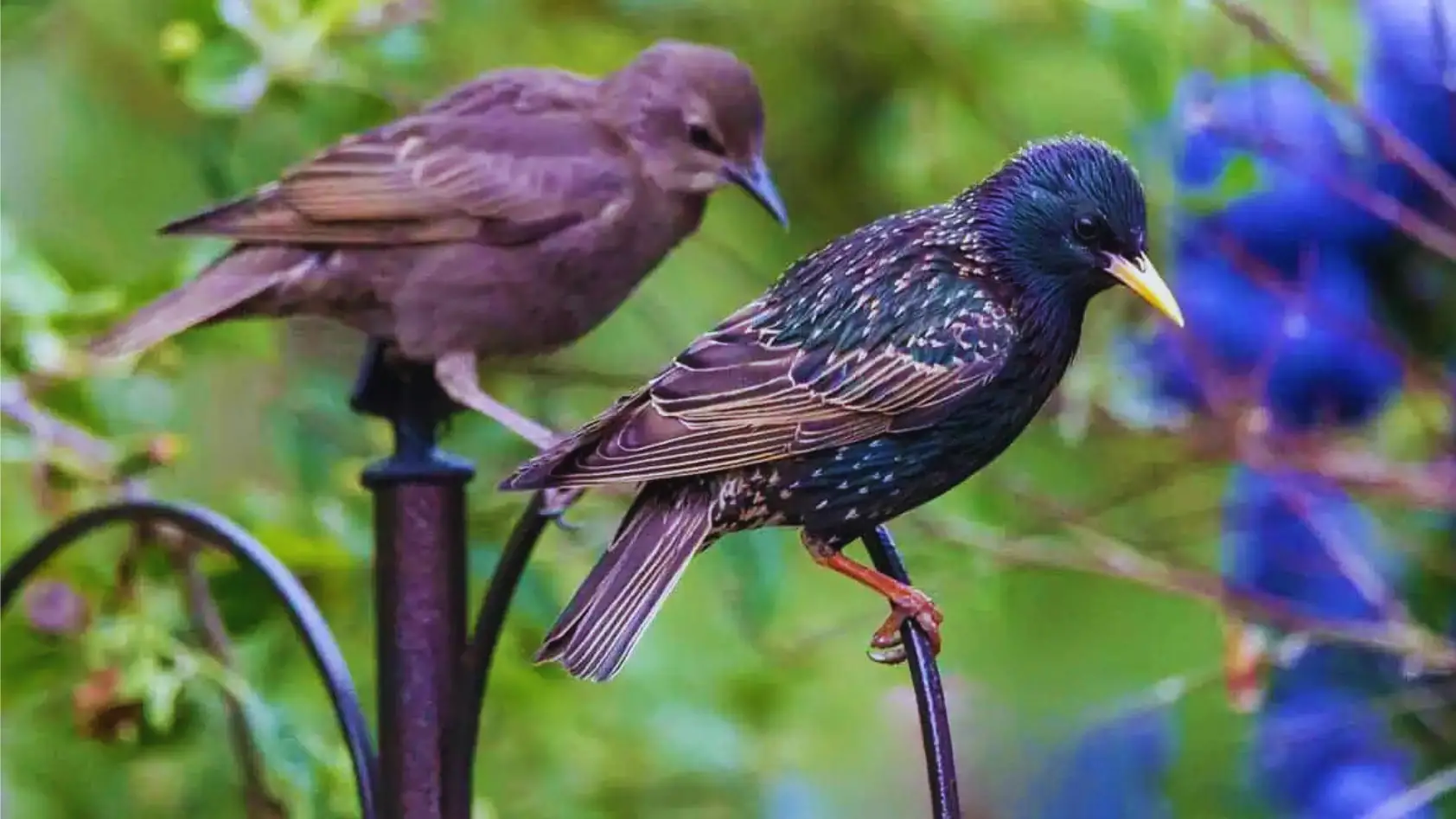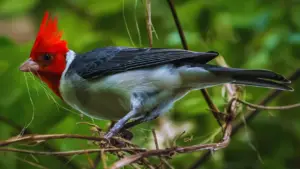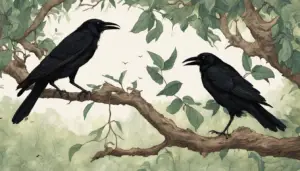If you are a bird enthusiast, you might have come across grackles and starlings during your birdwatching adventures. These two birds are often mistaken for each other, but they have significant differences in physical appearance, behavior, and ecology. In this article, we will explore the Grackle Vs Starling debate, providing you with key facts that will help you identify each bird and understand their ecological roles.
Key Takeaways:
- Grackles and starlings are two bird species that are often confused with each other, but they have significant differences in physical appearance, behavior, and ecology.
- Grackles are larger and have iridescent feathers, while starlings are smaller and have more muted coloring.
- Grackles are known for their aggressive territorial behavior, while starlings often form large flocks.
- Grackles and starlings have different nesting habits, migratory patterns, and dietary preferences.
- The impact of these birds on their environment has both positive and negative aspects.
Grackle Bird: Characteristics and Behavior
If you’re interested in understanding the differences between grackles and starlings, it’s important to first learn about the characteristics and behavior of grackles. Grackles are a member of the blackbird family, known for their dark iridescent feathers that shine blue, purple, or green in the sunlight.
Grackles are medium-sized birds, typically measuring around 12 inches in length and weighing between 3-5 ounces. They have long and slender tails, long legs, and a sharp, curved bill. Males and females look similar, but males are slightly larger and have longer tails.
When it comes to their behavior, grackles are known for being highly social birds. They often gather in large flocks, especially during the winter months. They are also vocal birds, with a variety of calls and songs that they use to communicate with other birds in their flock.
In terms of identifying grackles, there are a few key features to look for. They have a long, keel-shaped tail that is distinctive in flight, and their wings are pointed and triangular. They also have a distinctive, slightly curved bill that is black in color.
Overall, grackles are fascinating birds with unique physical characteristics and social behaviors. Understanding their behavior and appearance can help you better differentiate them from their close cousin, the starling.
Starling Bird: Characteristics and Behavior
Starlings are medium-sized passerine birds that belong to the Sturnidae family. They have a stocky build with short tails and triangular wings. Their plumage is black with glossy iridescence that appears green or purple in certain lighting. In the winter, their feathers often have white spots that disappear during the breeding season.
Starlings are often mistaken for blackbirds, but their bills are shorter and more pointed. They also have a distinctive walk, often moving their heads as they walk instead of bobbing their entire bodies.
Starlings are known for their mimicry abilities, mimicking the sounds of other birds, animals, and even machines. They have a complex vocal repertoire and can imitate up to 20 different species of birds, as well as phones, car alarms, and human speech. When communicating with each other, they use a variety of calls and whistles.
Starlings are highly adaptable and can thrive in a variety of environments, including urban and suburban areas. They primarily feed on insects, fruits, and seeds, and are also known to scavenge for food. During the breeding season, they switch to a diet high in animal protein, such as earthworms and insects, to feed their young.
Starlings are cavity nesters, meaning they build their nests in hollow trees, snags, or man-made structures like birdhouses. They often compete with other bird species for nesting sites. Females lay 4-6 eggs per clutch, and both parents take turns incubating the eggs and caring for the young.
Starlings are considered a pest species in some areas due to their habit of forming large flocks that can cause damage to crops and property. However, they are also beneficial to the environment as they help control insect populations, and their droppings provide nutrients for plants.
Aggression: Grackle Vs Starling
When it comes to aggression, grackles and starlings differ significantly. Grackles are known for their territorial behavior and can be quite aggressive towards other birds, particularly during the nesting season. They will defend their nests vigorously, often chasing away intruders and even attacking larger birds such as crows or hawks.
Starlings, on the other hand, tend to be less territorial and exhibit minimal aggression towards other birds. They are more social and will often form flocks with other starlings, roosting together in large numbers.
While grackles are known to be aggressive, they are not typically aggressive towards humans. However, they may become defensive if they feel threatened or cornered, so it’s best to give them plenty of space.
Sound and Vocalizations: Grackle Vs Starling
Grackles and starlings are both known for their vocalizations, but their sounds are distinct from one another. Grackles have a unique vocalization that is often described as a harsh, metallic “chack” or “chuck.” They are also known for producing a variety of other vocalizations, including whistles, clicks, and gurgles.
Starlings, on the other hand, are known for their ability to mimic other birds and sounds in their environment. They are able to create a variety of calls and songs, including imitations of car alarms, telephones, and even human speech. Starlings have a melodious song with a series of warbles, whistles, and trills.
It’s important to note that both grackles and starlings can be quite vocal, especially during the breeding season or when defending their territory. Their sounds can be heard both in urban and rural settings as they are known to adapt to different environments.
Nesting Behaviors: Grackle Vs Starling
Grackles and starlings have distinct nesting behaviors that allow them to create safe and secure homes for their young. While there are similarities between the two species, there are also notable differences in their nesting habits.
| Species | Nesting Locations | Construction Methods |
|---|---|---|
| Grackle | High tree branches, shrubs | Loosely woven nests made of twigs, grass, and other materials |
| Starling | Cavities in trees, buildings, and other structures | Tightly packed nests made of grass, feathers, and other materials |
Grackles typically build their nests high in tree branches or shrubs, using loosely woven materials such as twigs and grass. Starlings, on the other hand, prefer to nest in cavities in trees, buildings, and other structures, using tightly packed materials such as grass and feathers.
Another notable difference is that grackles tend to build their nests in more open areas, while starlings prefer enclosed spaces. Grackles also tend to use their nests for only one breeding season, while starlings may reuse theirs for multiple seasons.
Did you know? A group of starlings is called a murmuration.
Both species use their nests to protect their offspring from predators and the elements. By understanding their nesting behaviors, we can better appreciate the adaptability and ingenuity of these remarkable birds.
Migration Patterns: Grackle Vs Starling
Both grackles and starlings are known for their migratory behavior, with many individuals traveling long distances each year. However, there are some key differences between the two species when it comes to their migration patterns.
Grackles tend to be more sedentary than starlings, with some populations staying in the same location year-round. However, other grackles do migrate, typically moving south for the winter months. These migratory populations can travel significant distances, with some grackles flying as far as Mexico and the Caribbean.
Starlings, on the other hand, are highly migratory birds, with many individuals traveling long distances each year. Most North American starlings migrate south for the winter months, often traveling in large flocks. Some of these flocks can contain thousands of birds and can be quite spectacular to witness.
During the breeding season, both grackles and starlings tend to stay in one area, with males actively defending territories against other males. However, during the non-breeding season, these birds may join together in large flocks, often roosting in urban areas and causing a nuisance.
Dietary Preferences: Grackle Vs Starling
Grackles and starlings have distinct dietary preferences and feeding habits, reflecting their evolutionary adaptations to different habitats.
Grackles: These birds are omnivorous and opportunistic feeders, meaning they consume a wide variety of foods, including insects, small vertebrates, fruits, grains, and human scraps. They use their strong beaks to pry open seeds and insect exoskeletons, and are known to raid other bird’s nests for eggs and chicks. Grackles often form large flocks during the non-breeding season and may compete with other birds for food resources.
Starlings: These birds are also omnivores but primarily feed on insects and other invertebrates, such as earthworms and snails. They also consume fruits, berries, and some seeds. Starlings have a unique feeding technique known as probing, where they insert their beaks into the ground or other crevices to extract prey. This behavior allows them to access food sources that are not accessible to other birds. Starlings also feed in flocks but are less aggressive than grackles towards other bird species.
While grackles and starlings share some dietary overlap, their preferences and foraging methods differ, reflecting their adaptations to different niches in the ecosystem.
Adaptability: Grackle Vs Starling
Grackles and starlings are highly adaptable birds, capable of thriving in various environments. They have successfully adapted to live in urban, suburban, and rural areas, thanks to their remarkable ability to adjust to changing conditions.
Grackles, for instance, are known to have a higher tolerance for human disturbance than most bird species. They are often found in parking lots, outdoor cafes, and other human-inhabited environments. In contrast, starlings are more commonly found in rural areas or open fields but are also able to adapt to urban settings to some extent.
Both grackles and starlings are opportunistic feeders, which means they are skilled at finding food in a variety of settings. They are known to feed on insects, fruits, seeds, and even garbage.
Their adaptability also extends to their nesting behaviors. Grackles often build their nests in trees, shrubs, or man-made structures, such as utility poles or building ledges. Similarly, starlings build their nests in tree cavities, crevices, or man-made structures like birdhouses or gutters.
Overall, grackles and starlings have proven to be some of the most adaptable bird species, capable of living and thriving in various types of environments.
Population and Distribution: Grackle Vs Starling
Grackles and starlings are both widespread bird species, although their distribution patterns differ depending on various factors. In terms of population, both bird species have adapted well to human-altered environments, leading to their prevalence in urban and suburban areas.
| Grackle | Starling | |
|---|---|---|
| Population size | Abundant | Abundant |
| Distribution | North America, Central America, and the Caribbean | Eurasia, North America, and Australia |
| Habitat preference | Woodlands, agricultural fields, suburban areas | Urban areas, agricultural fields, grasslands |
Grackles are predominantly found in North America, Central America, and the Caribbean, while starlings have a broader distribution, inhabiting Eurasia, North America, and Australia. Habitat preference also differs between the two species, with grackles typically preferring woodlands, agricultural fields, and suburban areas, while starlings are often found in urban areas, agricultural fields, and grasslands.
The prevalence of these birds in urban and suburban areas has led to some controversy, as they can cause damage to crops and compete with native bird species for resources. However, their ability to adapt to a range of environments has also made them a popular subject of study for researchers interested in urban ecology and wildlife management.
Ecological Impact: Grackle Vs Starling
When it comes to ecological impact, grackles and starlings can have both positive and negative effects on their respective habitats.
On the positive side, both species are known to eat insects, which can help control populations of harmful pests. Additionally, grackles and starlings are both capable of consuming large quantities of seeds, which can help disperse plant species and promote biodiversity.
However, on the negative side, grackles and starlings can also have detrimental effects on other bird species. They are both known to be aggressive, often outcompeting native birds for resources such as food and nesting sites. In some cases, grackles and starlings have even been known to attack and kill other bird species.
Furthermore, both species can have negative impacts on crops and livestock. Grackles are known to feed on crops like corn and sorghum, while starlings have been observed damaging fruit trees and consuming livestock feed.
In general, the ecological impact of grackles and starlings is complex and varies depending on the specific habitat and ecosystem in question. However, it is clear that both species have the potential to influence the balance of local ecosystems in significant ways.
Conservation Status: Grackle Vs Starling

As with many bird species, the conservation status of grackles and starlings varies depending on the region and population in question.
In general, the International Union for Conservation of Nature (IUCN) lists both species as “Least Concern,” indicating that they are not currently considered to be at significant risk of extinction. However, this designation does not necessarily indicate that there are no conservation concerns for these birds.
In some areas, grackles and starlings may be considered invasive species. As such, efforts may be made to control their populations or limit their impact on native flora and fauna. Additionally, habitat loss and degradation due to human activities can pose a threat to these birds.
Some conservation efforts may focus on preserving or restoring suitable nesting sites and feeding areas for grackles and starlings. Others may aim to reduce human disturbances or mitigate the potential negative impacts of these birds on other species or ecosystems.
Ultimately, the conservation status of grackles and starlings is not a straightforward issue. While these birds may not be considered endangered, there are still important considerations and efforts underway to protect them and their habitats.
Human Interaction: Grackle Vs Starling
Grackles and starlings often have interactions with humans, as they are both common in urban and suburban areas. Here are a few things to keep in mind when encountering these birds:
- Grackles and starlings can become a nuisance, especially when they gather in large flocks. They may be noisy and messy, leaving droppings on buildings and cars.
- If you are trying to attract birds to your backyard, both grackles and starlings are known for their fondness for suet and seed. However, if you want to specifically attract other bird species, it’s best to avoid these foods as they may deter other birds.
- Some people find the vocalizations of grackles and starlings unpleasant. However, others appreciate the variety of sounds they produce.
- In some cases, grackles and starlings may cause damage to crops or compete with native bird species for resources.
- It is important to note that grackles and starlings are protected under the Migratory Bird Treaty Act, which prohibits harming or killing them without a permit. If you are experiencing problems with these birds, it is best to consult with local wildlife officials for advice on how to manage the situation.
Overall, while grackles and starlings may sometimes be a nuisance, they are important members of the ecosystem and should be treated with respect and care.
Conclusion
In conclusion, understanding the differences between grackles and starlings is essential for bird enthusiasts and casual observers alike. While these two species share some similarities, such as their black plumage and omnivorous diets, they have distinct characteristics and behaviors that set them apart.
Grackles are known for their iridescent feathers and raucous vocalizations, while starlings are recognized for their striking white-spotted plumage and mimicking abilities. Grackles are more aggressive and territorial than starlings, which can impact their interactions with other bird species.
Both grackles and starlings exhibit remarkable adaptability and can thrive in diverse environments, including urban and suburban areas. However, this adaptability can also have ecological impacts, as both species may compete with or displace native bird populations.
Despite their prevalence in many regions, both grackles and starlings face threats to their populations and habitats. Conservation efforts are necessary to protect these bird species and maintain the balance of our ecosystems.
Overall, learning about grackles and starlings offers valuable insight into the intricate world of birds and their role in our environment. By understanding their behaviors and ecological impacts, we can work towards creating a more harmonious coexistence with these fascinating bird species.
Grackle Vs Starling: FAQs
Q: What are the main differences between grackles and starlings?
A: Grackles and starlings have distinct physical characteristics and behaviors that set them apart. Grackles are larger and have longer tails, while starlings are smaller and have shorter tails. Grackles are known for their iridescent feathers, while starlings have spotted plumage. Additionally, grackles are more aggressive and territorial compared to starlings.
Q: How can I identify a grackle from a starling?
A: Grackles can be identified by their large size, long tails, and iridescent feathers that shine green, blue, or purple in the sunlight. They have yellow eyes and a long, downward-curved bill. Starlings, on the other hand, are smaller with short tails and spotted plumage. They have dark eyes and a short, straight bill. Observing these physical characteristics can help differentiate between the two bird species.
Q: What is the nesting behavior of grackles and starlings?
A: Grackles and starlings exhibit different nesting behaviors. Grackles typically build their nests in trees or shrubs, weaving them with twigs and grass. They prefer nesting near water sources. Starlings, on the other hand, often nest in cavities such as tree holes and man-made structures. They line their nests with feathers, leaves, and other soft materials. Understanding these nesting habits can assist in identifying their respective nests.
Q: Do grackles and starlings migrate?
A: Both grackles and starlings are migratory birds. Grackles migrate to warmer areas during the winter months, while starlings may also undertake seasonal movements. Their migration patterns vary, with grackles typically traveling in large flocks and starlings forming smaller groups. These migrations are influenced by factors such as food availability and weather conditions.
Q: What do grackles and starlings eat?
A: Grackles and starlings have different dietary preferences. Grackles are omnivorous, feeding on a variety of foods including insects, fruits, seeds, and small vertebrates. They have been known to raid crops and feed in open areas. Starlings primarily eat insects and fruits, but they also consume seeds and grains. They often forage on the ground and can be seen in large flocks searching for food.
Q: How do grackles and starlings impact the environment?
A: Grackles and starlings have both positive and negative ecological impacts. On the positive side, they help control insect populations and disperse seeds. However, their aggressive behavior and competition for resources can negatively affect other bird species. They may also cause damage to agricultural crops and create nuisance situations in urban areas.
Q: What is the conservation status of grackles and starlings?
A: Grackles and starlings are not currently classified as endangered or threatened species. Their populations are considered stable or increasing in many regions. However, conservation efforts are focused on monitoring their impacts on native bird species and mitigating any negative effects they may have on ecosystems.
Q: How can I attract or deter grackles and starlings?
A: If you want to attract grackles and starlings, providing food sources such as bird feeders with appropriate seeds, fruits, or suet may be effective. However, if you want to deter them, using deterrents like scare devices or modifying their preferred habitats can help. It’s important to consider local regulations and practices to ensure humane and environmentally friendly methods are used.














